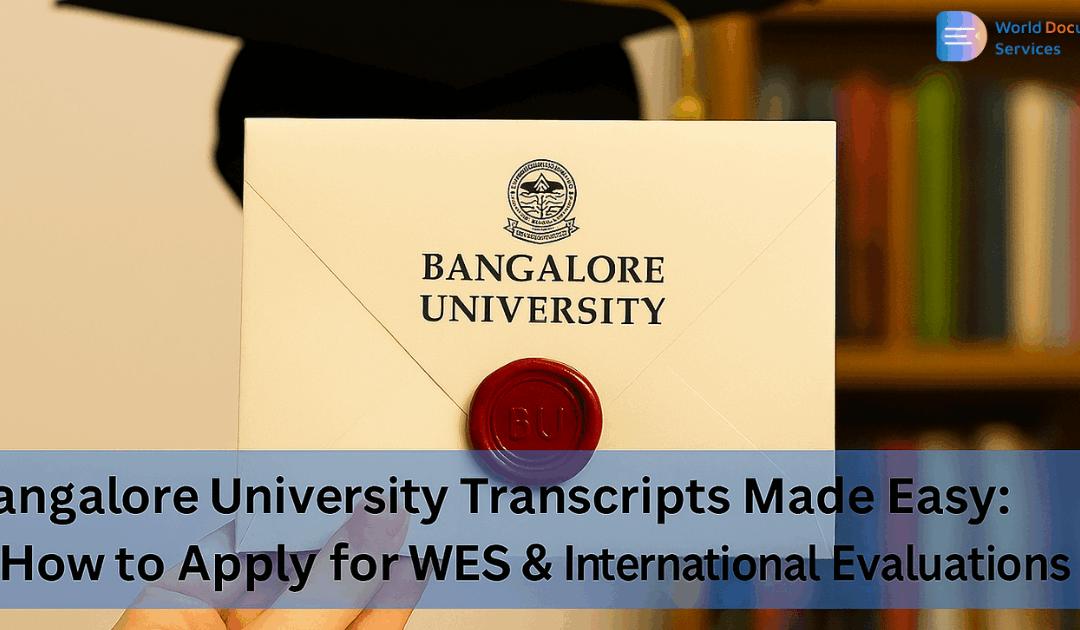
by Shipra Choudhary | Jul 1, 2025 | Transcripts from University
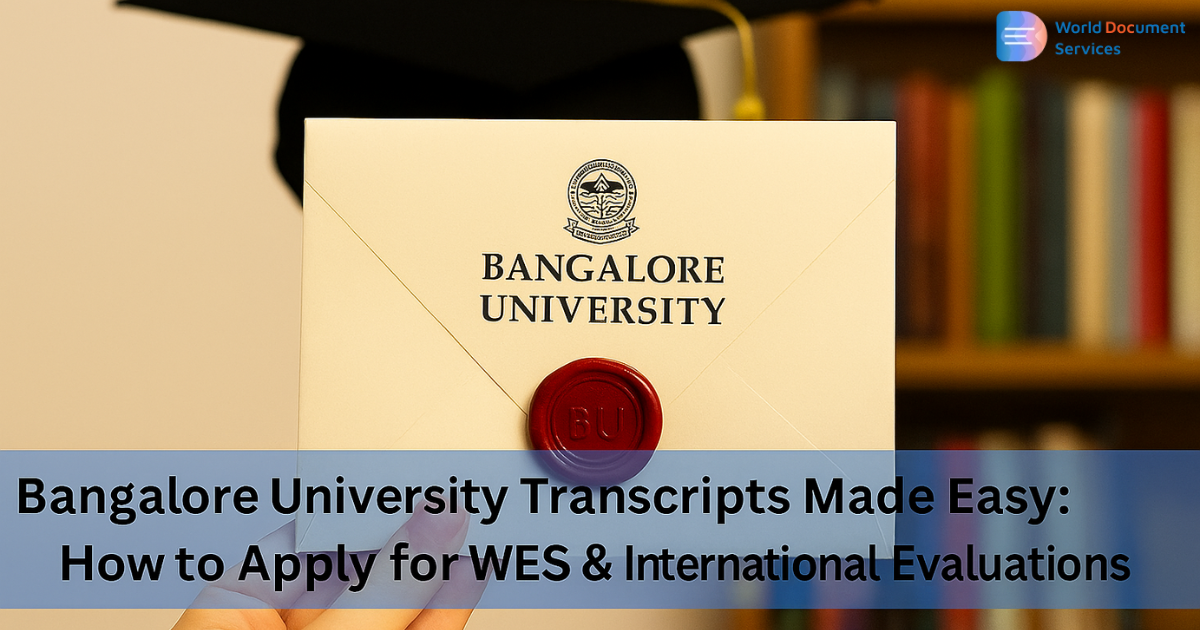
In today’s globalized world, whether you’re seeking a job abroad, want to go for a foreign degree, or need a WES or ECE qualification evaluation, official verified and authenticated records of all academic achievements are essential. For graduates and former students of Bangalore University, the journey starts with obtaining official Bangalore University transcripts.
This comprehensive blog will walk you through everything you need to know about the Bangalore University transcript application process including how to apply, required documents, processing time, and how to get your Bangalore University WES transcript or ECE evaluation done efficiently. Whether you’re in India or abroad, we’ll also show how World Document Services can make the entire process smooth and stress-free.
Need help with your Bangalore University transcripts? Contact Us Now!
What Are Bangalore University Transcripts?
Bangalore University transcripts are the government-issued documents of a student’s academic performance across all semesters. Each transcript includes subjects studied, marks obtained, credits earned, and details of the degree program. All transcripts should be stamped by the university and in a sealed envelope.
Transcripts are required for:
- Admission for overseas education
- WES or ECE credential evaluation
- PR or immigration
- Employment in some other country
Why Do You Need a Transcript from Bangalore University?
When you apply to WES or ECE, they require academic documents directly from the issuing university. Then, they assess whether the Indian qualifications attained are equivalent to the qualifications overseas. That’s why getting your Bangalore University transcript for WES or ECE needs to be accurate, verified, and sent directly by the university in a sealed envelope.
Step-by-Step: Bangalore University Transcript Application Process
Let’s talk about how to get your transcript from Bangalore University with simple and easy to follow steps.
Step 1: Gather Required Documents
You must prepare everything ahead of time before applying, like:
- Scanned copies of all semester-wise marksheet
- Degree certificate (Provisional/Final)
- ID proof (Aadhaar/Passport)
- WES Academic Records Request Form (if applicable)
- Passport size photograph
- Address proof (if you require a courier)
- Authorization letter (if using World Document Services or any third person)
Having accurate and legible copies speeds up the Bangalore University transcript process significantly.
Step 2: Bangalore University Transcript Online Application
The Bangalore University transcript process is made easier for current students and alumni through an online method. Here is how you can apply for a Bangalore University transcript online:
- Go to the official university link: https://buofc.inhawk.com/
- Click on ‘Apply for Transcript’ and register with a valid email ID.
- Fill in the required personal details along with course and year of passing details.
- Upload scanned copies of relevant mark sheets and certificates.
- Fill in the number of transcripts required.
- Fill in the mode of obtaining the transcript—l whether it’s self-collection, courier within India, or international courier (WES/ECE).
- Submit Payment Online.
Note: If you graduated in the 1990s or later, you can pay online. If you graduated before that, you’re going to have to print and send the application yourself. Thus, you want World Document Services to handle everything in this situation.
Step 3: Verification and Processing
So you must be wondering, what’s next after you submit and pay?
- Your application is cross-verified with the Bangalore University internal academic records.
- A transcript is generated of all the marks received per semester.
- Once created and stamped, the transcript gets put in a sealed envelope by Bangalore University.
The processing time for the Bangalore University transcript is 15 to 25 working days. This depends on your year of graduation and faculty.
Step 4: Transcript Delivery – Domestic & International
For the delivery, you can:
- Come and pick up your sealed envelope, or
- Choose local courier service, or
- Choose international delivery service to send your transcripts directly to WES, ECE, or any other evaluating agency
Please note that WES and other such agencies will only accept those transcripts postmarked from the university or from an authorized third party like World Document Services.
How to Apply for Bangalore University WES Transcript
If you’re planning to immigrate to Canada or the US, WES evaluation is often mandatory. Here’s how to apply for a Bangalore University transcript for WES:
- Download the WES Academic Records Request Form from www.wes.org
- Fill in your WES Reference Number
- Include the form with your transcript application
- Ensure that Bangalore University sends the sealed transcript directly to the WES Canada/US address
At World Document Services, we help you with:
- Completing and submitting your application
- Attaching the WES form correctly
- Ensuring proper university-sealed packaging
- Dispatching transcripts to WES with tracking details
Bangalore University ECE Transcript Process
If you’re applying through ECE, the process is very similar:
- Mention your ECE Reference Number
- Fill out ECE forms if required
- Request Bangalore University to send transcripts directly to ECE’s address
World Document Services can coordinate every step of the Bangalore University ECE transcript process, so you don’t have to worry about international couriers or document tracking.
Bangalore University Transcript Requirements: Key Guidelines
To ensure your application is not rejected, keep the following Bangalore University transcript requirements in mind:
- All mark sheets must be clear, legible, and match the university records
- Name on ID proof must match the academic records
- Upload high-resolution documents
- Use your official name as per the degree certificate
- Always include your WES/ECE reference number on the envelope and request forms
How World Document Services Can Help
Navigating the Bangalore University transcript application process can be confusing, especially if you’re living abroad or working full-time. At World Document Services, we offer end-to-end support for students and professionals who want a hassle-free transcript service.
Our Services Include:
- Document scanning and validation
- Online and offline application management
- Regular follow-ups with the university
- Attestation of degree/mark sheets if required
- Safe couriering to WES, ECE, CES, IQAS, or any international address
- Real-time status updates
Why Choose Us?
- 100% success rate in transcript processing
- Dedicated experts familiar with Bangalore University procedures
- Secure handling of personal documents
- Save time, avoid delays, and stay stress-free
Thousands of applicants have trusted World Document Services to obtain transcripts from Indian universities, including Bangalore University.
Common Mistakes to Avoid
Avoid these errors to ensure a smooth transcript application:
- Missing documents or poor-quality scans
- Not including WES/ECE reference numbers
- Not verifying personal details before submission
- Sending transcripts yourself (not accepted by WES)
- Applying through unofficial portals
Want to stay worry-free? Let us handle your transcript needs.
FAQs
Q: How long does it take to get transcripts from Bangalore University?
A: Typically, 15–25 working days, depending on your year of graduation and the accuracy of your documents.
Q: Can I apply for Bangalore University transcripts online?
A: Yes, via the official portal. However, older records may still require manual submission, which we can help with.
Q: Does WES accept transcripts sent by applicants?
A: No. Transcripts must be sent directly from the university or through an authorized service provider.
Q: Can World Document Services help if I live outside India?
A: Absolutely! We specialize in helping NRIs, international students, and working professionals.
Q: What if my mark sheet or degree has an error?
A: Reach out to our team, and we’ll guide you on the correction and re-issuance process.
Final Thoughts
Obtaining your Bangalore University transcripts doesn’t have to be a stressful process. With the right documents, timely application, and expert support, you can get your transcripts delivered to WES, ECE, or your international university in no time.
At World Document Services, we take pride in offering fast, reliable, and secure services so you don’t miss deadlines or deal with paperwork hassles.
Need help getting transcripts from Bangalore University?
Contact World Document Services today or visit www.worlddocservices.com to start your application.
Download the World Document Services App
You may enjoy a hassle-free experience by downloading our mobile app from either the App Store or the Play Store. It works with both iOS and Android devices.
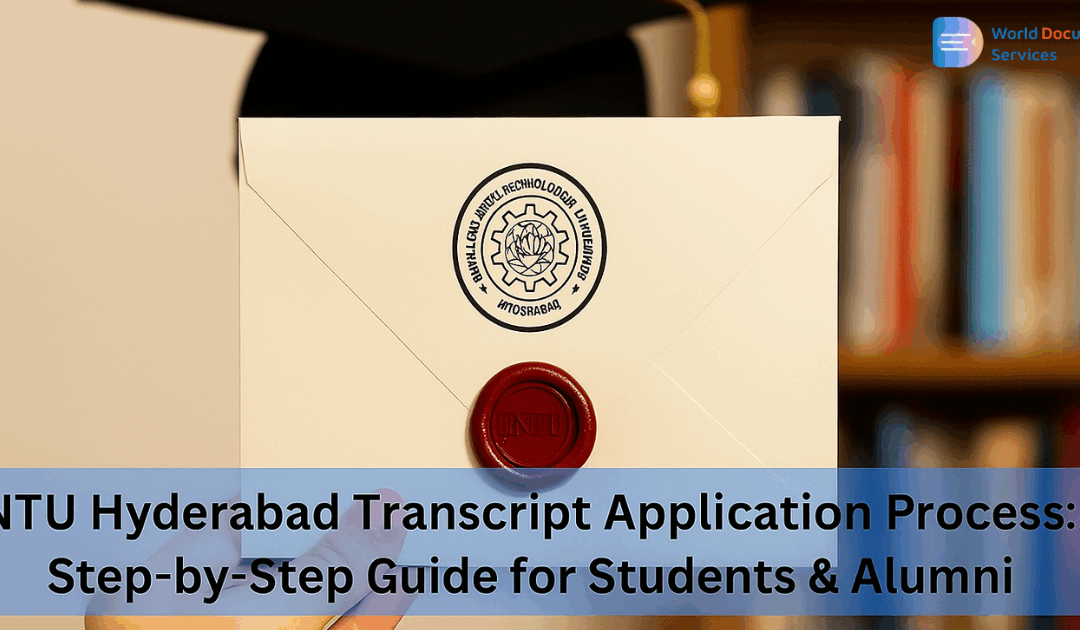
by Shipra Choudhary | Jun 26, 2025 | Most Viewed, Transcripts from University
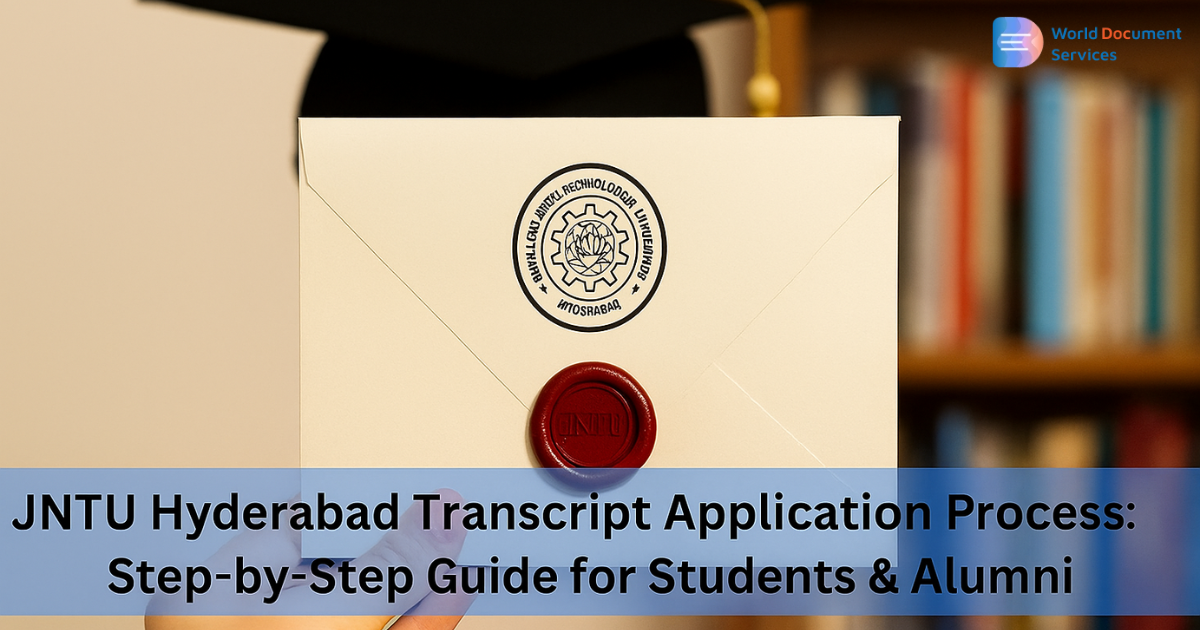
If you’re planning to study abroad, immigrate, or apply for professional licensing in countries like the USA, Canada, or Australia, getting your academic transcripts in order is a crucial first step. If you’re a graduate of Jawaharlal Nehru Technological University Hyderabad (JNTUH), this blog is your go-to guide for understanding the complete JNTU Hyderabad transcript application process.
Whether you’re a current student or an alumnus, this post will walk you through how to get transcripts from JNTU Hyderabad, including how to apply, required documents, fees, online procedures, and how these transcripts are used for WES and other credential evaluation agencies.
Need help with your JNTU Hyderabad transcripts? Contact Us Now!
What Are JNTU Hyderabad Transcripts?
JNTU Hyderabad transcripts are the official documents released by JNTU Hyderabad that make up your university record. They contain subjects along with grades obtained on a per semester basis with a degree awarded date at the end. JNTU Hyderabad transcripts are provided in a sealed envelope with the stamp and signature of the JNTU Hyderabad authorities and this is needed for validation of your degree from India on an international level.
JNTU Hyderabad transcripts are required for:
- Higher education abroad
- Visa and Green Card applications
- WES, ECE, CES, and other agency evaluations
- Indian candidates seeking jobs with MNCs
- Applications for scholarships or fellowships
Why Are Transcripts from JNTU Hyderabad Important?
If you plan to go through WES or any other evaluation agency, they need you to have your JNTU Hyderabad transcripts to let potential universities/authorities know of your authenticity. Agencies like World Education Services cannot assess your degrees and grades without the right transcripts.
Thus, regardless of whether you are pursuing an international master’s degree or an accreditation assessment for visa needs, it is mandatory that the university create and send transcripts in a sealed envelope.
Step-by-Step Guide: JNTU Hyderabad Transcript Application Process
To simplify the process, here is an overview of the JNTU Hyderabad transcript application process:
Step 1: Prepare the Required Documents
To initiate the process, make sure you have the following documents :
- Photocopies of all semester-wise mark sheets
- Consolidated marks memo
- Degree certificate (Provisional or original)
- SSC/10th certificate (as proof of date of birth)
- Government-issued ID proof (like Aadhaar or passport)
- WES Academic Records Request Form (if applicable)
- Authorization letter (if applying through an agency like World Doc Services)
These are the essential elements for your JNTU Hyderabad transcript application, and they need to be processed properly.
Step 2: JNTU Hyderabad Transcripts Online Application
For your ease, JNTUH has an option to apply for JNTU Hyderabad transcripts online through the student services portal. The process is as follows:
- Visit the official JNTUH exam branch website: https://studentservices.jntuh.ac.in
- Select “Transcript” from the list of services.
- Register using your hall ticket number, email ID, and mobile number.
- Fill in the required details like the number of copies needed, purpose, which country it’s destined for (if applicable), etc.
- Scan and upload your semester wise marksheets and degree certificate.
- Pay the required fees (transcript + processing fee).
You’ll be provided with a reference number for tracking after submission.
Step 3: Physical Submission (if required)
After applying for transcripts with JNTU Hyderabad online, certain situations still require hard copy submission of documents to be submitted at the university or sent by post.
So, in this case, if you’re unable to apply directly to the JNTUH yourself, you can reach out to a trusted third party like World Doc Services who will fill out the form and apply on your behalf with tracking.
Step 4: Processing Time
The general processing and dispatch time for JNTU Hyderabad transcripts is 10-20 working days. It may extend based on the workload and verification of documents. Do not raise requests for delays during peak times, when admissions are on or during festival times, instead acknowledge such information and apply as per your necessities.
If you apply through World Doc Services, we keep you updated at every step with follow-ups so that you won’t have any delays in processing.
How to Get Transcripts from JNTU Hyderabad for WES
When you’re applying to WES, it requires something specific from you. Therefore, in regards to the JNTU Hyderabad transcript for WES requirement, you need to take care of the following things :
- Make sure your WES reference number is on the envelope as well as the Academic Records Request Form.
- You may also need to provide WES information on the JNTUH student services portal.
If you let us handle the order through World Doc Services for your degree evaluation, you can rest assured that we will have everything submitted on your end, clear indication of your reference number, and that your transcripts will arrive safely at WES Canada/WES USA.
How We Help
If you’re overwhelmed with the process, don’t have all your documents available, and/or live internationally, World Doc Services is a quick, professional way for you to get your transcripts from JNTU Hyderabad without any hassle. Here’s how we help:
- Complete JNTU Hyderabad transcript process remotely
- Personal assistance for document submission and return
- Courier pick and drop service
- Communication with the university on your behalf
- Form filling and submission
- Transcripts sent to WES, ECE, or any other college in a sealed envelope
We’ve helped thousands of students and professionals, both in India and abroad in getting their JNTU Hyderabad transcripts which were required for further education and jobs online and offline.
Benefits of Choosing World Doc Services
- Completely ONLINE: You don’t have to visit campus at all
- Faster processing: We follow up often, so there’s no delay in work
- 100% Error-free: We do not allow any mistakes in your application
- Budget friendly: Cheap transcript providers
- Document Security: Your educational documents are in safe hands with us.
Common Mistakes to Avoid When Applying for JNTU Hyderabad Transcripts
These mistakes will only complicate the process further, so take care of the following things:
- Not sending all semester marksheets
- Not sending WES reference number
- Sending blurry/unverified documents
- If you have paid excess or less fees
- Not providing evaluation agency an unsealed envelope
- Not applying in advance for university/immigration purposes.
These mistakes could delay your application by days, weeks, even months. It’s better to outsource this process because if it jeopardizes your future, why even take a chance?
Frequently Asked Questions (FAQs)
Q: How long does it take to receive transcripts from JNTU Hyderabad?
A: Generally, it takes about 10-20 working days after successful submission of application and documents.
Q: Can I apply for transcripts from JNTUH online?
A: Yes, there’s a distinct JNTU Hyderabad transcripts online application link by JNTUH available for current students and alumni.
Q: Is it mandatory for JNTU to send transcripts directly to WES?
A: Yes. WES stipulates that the transcripts should be sent directly from the university in a sealed and signed envelope.
Q: How many sets of transcripts should I order?
A: It depends on how many universities/credentialing agencies you’ll be applying to. It’s also recommended to apply for 2-3 additional copies if possible.
Q: Can World Doc Services help if I’ve lost some of my documents?
A: Absolutely! Along with submitting your transcript application request, we can help you in obtaining your lost mark sheets or certificates from JNTUH.
Final Thoughts
Getting your transcripts from JNTU Hyderabad doesn’t have to be stressful or time-consuming. With proper guidance and the right support, you can breeze through the process and focus on your bigger goals, be it a master’s abroad, immigration, or a professional career overseas.
With World Doc Services, your entire JNTU Hyderabad transcript application process is completed in no time with 100% correctness at a reasonable price. Our goal is to eliminate confusion, save you time, and ensure transcripts reach where they need to go when they need to go.
Want your JNTUH transcripts? World Doc Services can get them for you. Visit www.worlddocservices.com to get in contact with their team, and they’ll take care of everything.
Download the World Document Services App
You may enjoy a hassle-free experience by downloading our mobile app from either the App Store or the Play Store. It works with both iOS and Android devices.
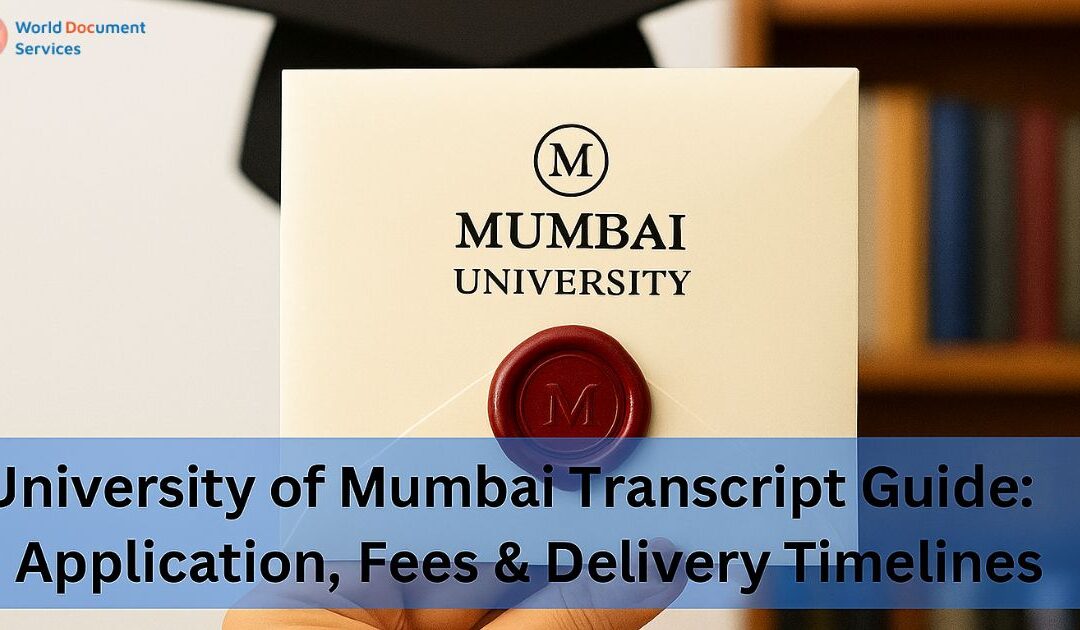
by Shipra Choudhary | Jun 23, 2025 | Most Viewed, Transcripts from University
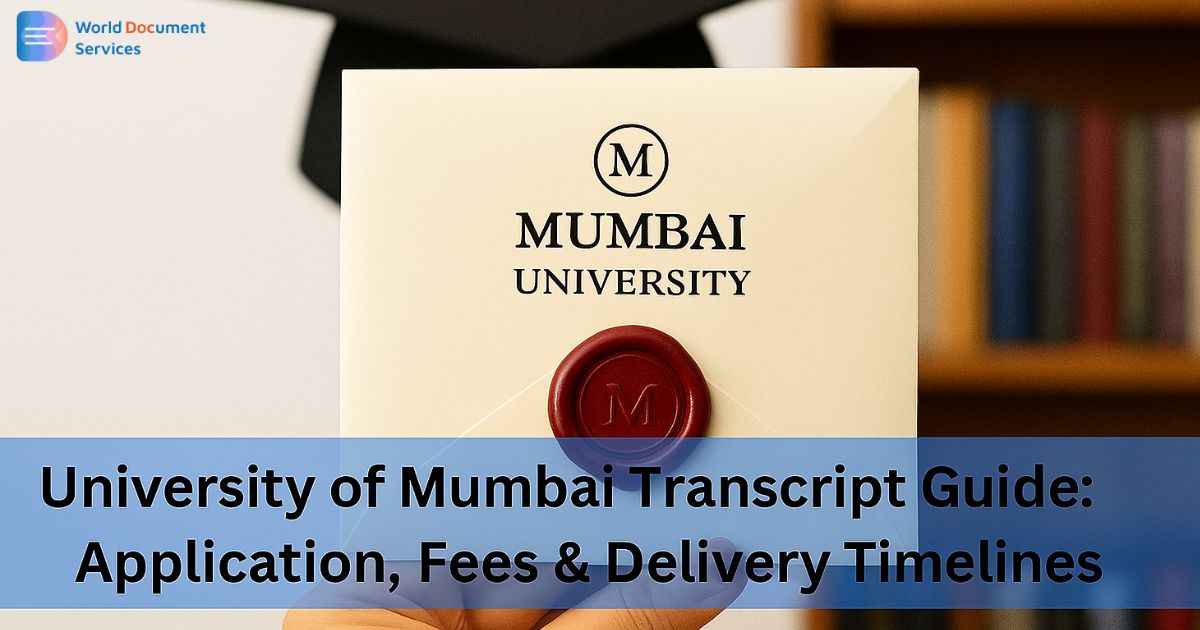
Whether you’re planning to study abroad, immigrate, or apply for credential evaluation from organizations like WES or ECE, one essential step is getting your academic records in order. If you’re a graduate or current student of the University of Mumbai, obtaining official University of Mumbai transcripts is critical to validate your education credentials for international use.
This guide is tailored to help you understand the complete Mumbai University transcript process, right from application to delivery timelines. Whether you’re a student in India or an alumnus living abroad, we’ll walk you through every detail, including how to apply for transcripts from Mumbai University, the documents required, online application procedures, delivery modes, and how World Document Services can help.
Need help with your Mumbai University transcripts? Contact Us Now!
What Are University of Mumbai Transcripts?
Mumbai University transcripts are your semesters’ officially attested records from the university in a consolidated formatted version with all marks, subjects, achievements, etc. It comes in a sealed envelope with the signature and stamp of the concerned authority in Mumbai University.
They’re required for:
- Studying abroad
- WES, ECE verification
- Immigration
- Employment
- Licensing
If you’re immigrating to Canada, USA, Australia, or UK for studying purposes or licensing, chances are you’re going to require transcripts from Mumbai University.
Why Are Transcripts from Mumbai University Important?
WES, ECE, and international universities do not acknowledge photocopies or self-attested mark sheets of yours when applying for admission or evaluation purposes. You need an attested, sealed transcript which should be sent to the concerned university/institution from Mumbai University.
Getting accurate and complete Mumbai University transcripts ensures that your educational background is accepted abroad, helping avoid unnecessary delays or rejections in your application.
Step-by-Step Mumbai University Transcript Application Process
Step 1: Gather Required Documents
Before applying, make sure you have the following documents ready:
- All semester-wise mark sheets (attested copies)
- Degree certificate (Provisional or Final)
- SSC/HSC certificates for identification
- Aadhaar Card or Passport (for ID proof)
- WES Academic Records Request Form (if applying for WES Canada/USA)
- Letter of Authorization (if applying via World Document Services)
These documents are essential for a successful Mumbai University transcript application.
Step 2: What is the process to apply for Transcripts from Mumbai University – Online or Offline?
Mumbai University has also taken the initiative of digitizing the process of applying and receiving transcripts. The process to apply for a transcript from MU is as follows:
Option 1: Online Procedure to Apply for Mumbai University Transcript
- Visit the University of Mumbai website: https://mu.ac.in
- Navigate to “eTranscript” or “Examinations”.
- Enter personal information along with details of education.
- Attach scanned copies of mark sheets and degree.
- Specify the number of transcripts required.
- Select the mode of delivery, whether In Person (yourself), Courier to your address, or Courier to WES/ECE.
- Make a payment via debit or credit card on the website/portal (Usually INR 1,000–2,000 per set plus courier fee).
- You will receive a receipt and an application ID, so you can track this later.
Disclaimer: Some faculties may also require the submission of documents to the university physically. This is where World Document Services comes in handy.
Option 2: Physical Submission (For Certain Faculties)
If you need to apply physically, this is for certain faculties or for courses that have been around for some time, here you will have to go to the campus or the corresponding center to apply physically and submit the documents.
If you’re not in Mumbai, if you’re a foreign national who needs help, you can authorize World Document Services. They will go on your behalf.
Step 3: Verification & Processing
After submission, it takes the university some time to validate your documents and confirm your academics. They check what you’ve submitted to see if it matches what’s in their database.
Mumbai University transcript process takes anywhere between 15 to 30 working days based on faculty, year of passing, and document availability.
How to Get Transcripts from Mumbai University for WES
When getting transcripts from Mumbai University for WES, you need to ensure WES gets them properly so follow these steps:
- Get the WES Academic Records Request Form from the WES site and fill it in.
- Mention your WES Reference Number on the Request Form and on the envelope you’re providing for the transcript.
- When filling in the requests, mention Courier to WES as the purpose of delivery.
- Ensure that the university sends your transcripts directly to WES in a sealed envelope.
Whether you’re using World Document Services for your application or not, we will complete the Mumbai University transcript WES process from application to your secure courier to WES.
Why Choose World Document Services?
Applying for transcripts from Mumbai University can be complex, especially if you’re unfamiliar with the process or living outside India. That’s where World Document Services steps in:
Our Services Include:
- End-to-end transcript application support
- Scanning and documentation assistance
- Follow-up with university officials
- Sealed transcript dispatch to WES, ECE, IQAS, CES, and other organizations
- Safe and secure international courier services
- Attestation of degree, mark sheets, and transcripts
Benefits of Working with Us:
- No need to visit Mumbai University in person
- Time-saving and stress-free
- Error-free applications and guaranteed acceptance
- Real-time updates on the status of your application
- Affordable, transparent pricing
We’ve helped thousands of students and alumni get transcripts from Mumbai University quickly and without complications.
What Students Do Wrong
Common errors students make when applying for transcripts include:
- Applying with insufficient or unclear documents
- Forgetting the WES Reference Number
- Sending the transcripts themselves to WES (WES won’t accept it!)
- Not getting back to their university
- Paying the wrong amount
The best way to avoid all this hassle is to use a third party transcript service provider like World Document Services.
Frequently Asked Questions (FAQs)
Q: Can I get Mumbai University transcripts online?
A: Yes. As of now, all the faculties endorse a Mumbai University transcript online application. Only for very old courses, there might be a possibility of having to submit a hard copy.
Q: How long does it take to get transcripts from Mumbai University?
A: It differs from faculty to faculty and year of passing, but on average 15 to 30 working days.
Q: Can World Document Services help if I live outside India?
A: Absolutely! We understand the requirements of international students and alumni and aid in receipt and legitimate dispatch of transcripts.
Q: Are transcripts and attested mark sheets the same?
A: A transcript is the consolidation of all your marks from all semesters into one document. An attested mark sheet is a certified document for each semester separately.
Q: Is it mandatory to send transcripts directly to WES?
A: No. Universities are obligated to send transcripts in a sealed envelope to WES on their own. The same is true for all credential evaluation services.
Final Thoughts
Getting your transcripts from the University of Mumbai is the final step in your journey to becoming an international student and professional. It can be overwhelming, but the right tools can genuinely make the process easier.
When you work with World Document Services, you never have to worry about filling out forms, couriers taking too long, or packages getting lost in transit. We provide professional, hassle-free services so you can get back to what’s important: Your Future.
Need transcripts from Mumbai University? Get in touch with World Document Services and have the professionals do all the heavy lifting for you! Visit www.worlddocservices.com or call us!
Download the World Document Services App
You may enjoy a hassle-free experience by downloading our mobile app from either the App Store or the Play Store. It works with both iOS and Android devices.
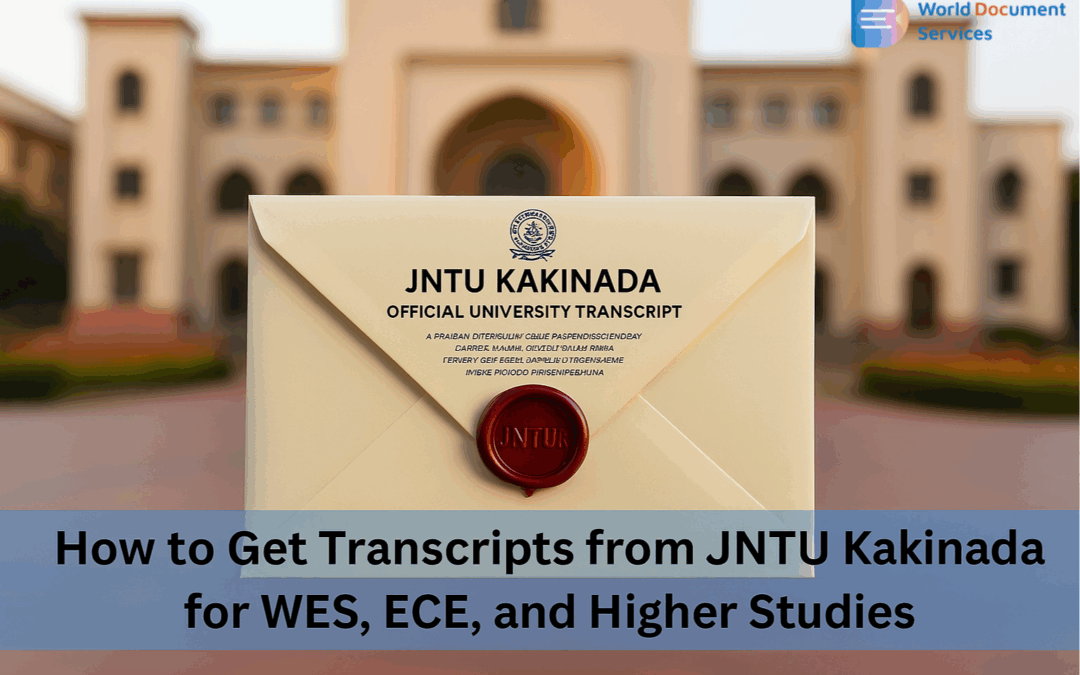
by Shipra Choudhary | Jun 11, 2025 | Most Viewed, Transcripts from University
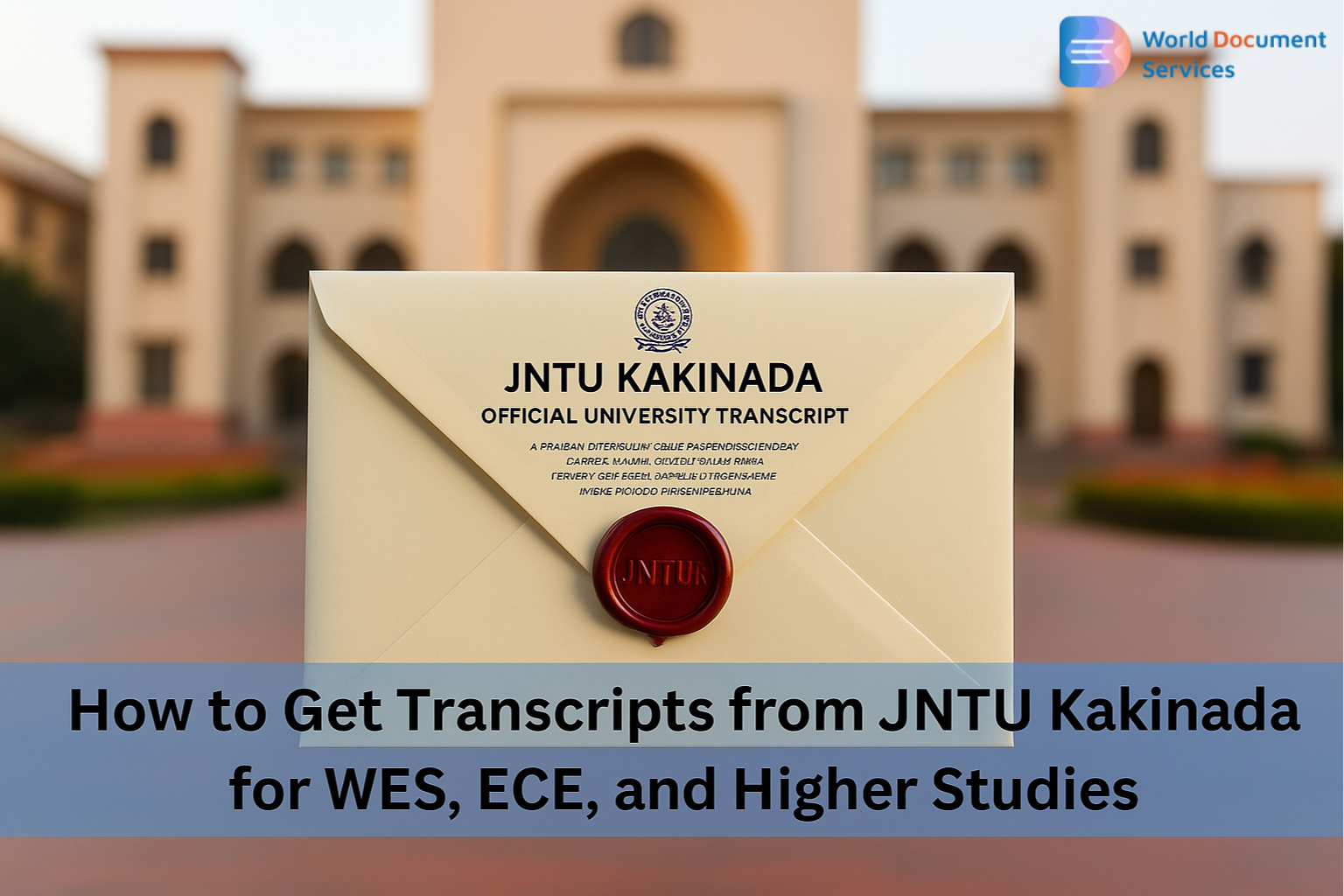
Whether you are planning to study for your Masters in USA or Canada or applying for a PR visa in Canada or needing due diligence for permanent residency or job licensing abroad? This blog explores how to secure your JNTU Kakinada transcripts for WES and ECE needs, whatever academic documents you need to send along with the transcripts, and a fool-proof method of doing it yourself or through an agency such as World Document Services.
Need help with your JNTU Kakinada transcripts? Contact Us Now!
Why Are JNTU Kakinada Transcripts Important?
JNTU Kakinada transcripts are detailed documents of your semester-wise marksheets, subjects, credits, grades and your overall performance. You need transcripts from JNTU Kakinada for:
- Postgraduate studies abroad
- Immigration purposes
- WES, ECE, IQAS, CES, and other agencies for verification purposes
- Global job applications
- Professional licensing
These are all sealed and signed from the university, which means they are an authorized representation of your educational history. Without transcripts, you will not be able to continue with most international applications.
Who Needs JNTUK Transcripts?
You need to get transcripts from JNTU Kakinada if:
- You are applying for further studies abroad
- You want your credential evaluation done (WES or ECE)
- You have applied for permanent residency (outside India)
- Your employer or licensing body abroad requires you to verify your academic records
Understanding the JNTU Kakinada Transcript Process
The JNTU Kakinada transcript procedure might seem overwhelming, particularly when you haven’t dealt with such documentation and don’t have access to the on-site university. However, knowing the procedure makes things easier on your end.
Here’s a detailed, step-by-step guide to help you through the JNTUK transcript application process.
Step-by-Step Guide to Get Transcripts from JNTU Kakinada
Step 1: Gather Required Documents
Before you apply for JNTUK transcripts (offline or online), ensure you have the following:
- All semester-wise mark sheets (mostly photocopies)
- Provisional or degree certificate
- SSC/10th certificate (for name and DOB verification)
- Government-issued ID proof (Aadhaar card or passport)
- Transcript application form (available on the JNTUK website)
- Authorization letter (third party application like a agency or a friend)
- WES or ECE Academic Records Request Form (if required )
Having all necessary documents for JNTU Kakinada transcripts ready for WES or ECE evaluation makes the process seamless.
Step 2: Fill the Transcript Application Form
The transcript application form can be downloaded from the JNTUK website or it can also be obtained from the Examination Branch in person. Fill in all required fields which include:
- Hall Ticket No.
- Year of passing
- No. of transcripts required
- Purpose for transcripts (WES, ECE, studies, etc.)
Note: Be precise, any error may delay your processing time.
Step 3: Pay the Required Fees
As of now, the fees to obtain a transcript is:
- 200 INR per transcript(can vary)
- Extra international courier charges
- Payment done through SBI Collect or other means like UPI
Whatever the case, keep a copy of your payment receipt because it might be required later.
Step 4: Submit Your Application
The filled form, required documents, and payment receipt must be submitted at the university either in person or via post. If you’re not in Kakinada, applying through World Doc Services is a practical alternative, we take care of everything from form filling to university follow-ups.
Step 5: Processing Time
Average processing time for transcript requests by the University is 15-25 business days. This may vary due to the volume of requests, university breaks and holidays.
However, World Document Services makes this a faster turnaround with diligent follow-up and managerial expertise.
JNTUK Transcripts for WES: What You Should Know
If your requirement is for WES Canada or WES USA, your transcripts need to be:
- Mailed by JNTUK to WES in a sealed envelope which is signed and stamped
- Accompanied by WES Academic Records Request Form
- Stamped with WES number
WES will not accept any transcripts sent by the student or any other third party. They must come from the university. With World Document Services, your JNTUK transcripts for WES will be in the correct format. We will make sure of that.
JNTU Kakinada Transcripts for ECE: What’s Different?
Applying for JNTU Kakinada transcripts for ECE is on the same path, but you need to include the ECE Academic Records Request Form in the sealed transcript envelope. Also, it is essential that the university issues your transcripts to ECE for credential purposes.
We take care of this whole step for you and ensure your JNTU Kakinada transcripts for ECE are sent, stamped, to the correct location.
Can You Apply for a JNTUK Transcript Request Online?
JNTUK does have an online portal that digitizes certain aspects of the service, such as paying fees. However, JNTUK transcript request online is not an option. You still need to apply in person to submit and process the application.
But don’t worry, World Document Services is here to bridge the gap. We provide a fully online experience. You apply from the comfort of your home in India or overseas, and we handle everything in person at JNTU Kakinada on your behalf.
Common Mistakes to Avoid
When you apply for your JNTU Kakinada transcripts, make sure you:
- Submit all the marksheets including the consolidated ones
- Provide correct academic details like Hall Ticket No., DOB, Year of Passing
- Submit an accurate evaluation form (WES or ECE)
- Submit payment and attach the proof of payment submission
- Apply by post using a reliable courier service
- No opened envelopes, transcripts should come in sealed envelopes
Avoiding these mistakes can save you weeks of processing delays. And if you choose World Document Services, we eliminate these errors from the start.
How World Document Services Can Help You Get Transcripts from JNTU Kakinada
We ensure that all your transcript needs are met with guidance on:
- The entire transcript procedure of JNTU Kakinada
- Preparation of documents
- Document collection with safety and security
- Application submission to the university in no time
- Application follow-up and status notification at every stage
- Sending to WES, ECE or any International University
When you apply through us, we are your third-party representative within JNTUK and all documents are submitted and processed without error or extended delay.
Why Us?
- We do all the paperwork for you
- You don’t have to go to Kakinada
- We manage your sensitive documents
- We are Affordable and you can save your precious
Be a part of thousands of students and professionals who got their JNTUK transcripts for WES and ECE through us, and allow us to help you, too!
Final Thoughts
Transcripts are required documents once your formal education has ended. Whether applying for a master’s program abroad, or applying for immigration to Canada, or having WES or ECE evaluate your degrees, transcripts are the first step to your new life.
The JNTU Kakinada transcript process may sound tedious, but it isn’t as long as proper assistance is rendered with the professional handling by World Document Services.
Frequently Asked Questions (FAQs)
Q: How long does it take to get transcripts from JNTU Kakinada?
A: The time taken is about 2 to 4 weeks depending on the number of applications received and the time taken for verification.
Q: Can I apply for JNTUK transcripts without visiting the university?
A: Yes you can but World Document Services can complete the application and submit the same without you having to budge an inch.
Q: Are JNTU Kakinada transcripts valid for WES and ECE?
A: Yes, both WES and ECE accept transcripts but they should be sent by the university in a sealed envelope.
Q: How many sets of transcripts should I apply for?
A: It all depends on how many colleges or evaluation services you’re applying to. We suggest you order 2-3 extras.
Q: What if I don’t have all my mark sheets?
A: You can reach out to us, we can help you secure any mark sheets from the university that you might not possess.
Ready to get started with your JNTUK transcript application?
Reach out to World Document Services today and let our experts guide you through the experience! Visit www.worlddocservices.com or reach out for a free consultation!
Download the World Document Services App
You may enjoy a hassle-free experience by downloading our mobile app from either the App Store or the Play Store. It works with both iOS and Android devices.
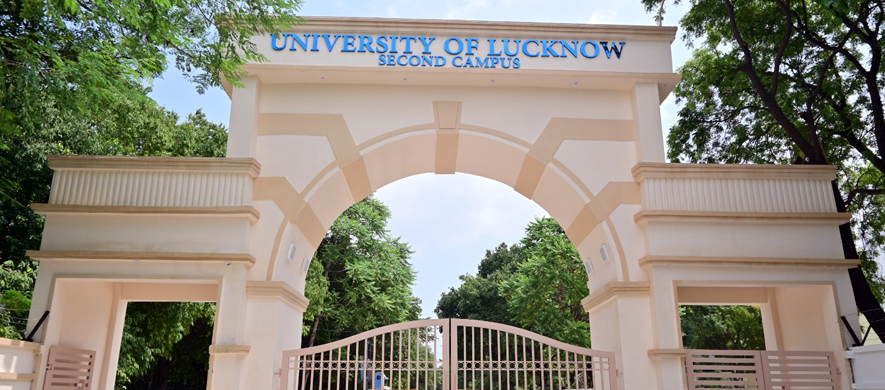
by Shipra Choudhary | Jun 3, 2025 | Transcripts from University

Many Lucknow University graduates might find themselves in need of transcripts as they pursue higher studies abroad or get their degrees evaluated through WES or ECE. If you’re applying for higher studies overseas or applying for a work visa/PR/License abroad, you must have your transcripts from Lucknow University. This blog is for all undergraduate and postgraduate alumni of the University of Lucknow who require documents for WES or ECE applications.
In this blog, we’ll cover the particulars of the university transcript, how to apply for it through the online university portal, and how these transcripts will be used for WES, ECE, etc. evaluation bodies.
Need help with your Lucknow University transcript? Contact Us Now!
What Are University Transcripts?
Before we get into the Lucknow University transcript process of application, it’s important to understand what transcripts are. A transcript is a university certified academic record of all the courses taken, marks obtained, and degree awarded. Such documents are signed and stamped by the Controller of Examinations or other authorized signatory from the university.
Transcripts are required for:
- Higher education abroad
- Immigration processes
- International Credential evaluation bodies (WES, ECE, IQAS, etc.)
- Employment in foreign countries
Why You Need University of Lucknow Transcripts
The University of Lucknow transcripts are verification of your performance, and transcript evaluation is integral in determining your degree equivalency. Evaluation agencies like WES (World Education Services) or ECE (Educational Credential Evaluators) require the transcripts from the University of Lucknow to determine that your degree is legitimate and equivalent to theirs.
Whether you’re taking admission in a Master’s program in the USA or Canada or need an evaluation equivalent from abroad, you need to get Lucknow University to send an official transcript to ECE or WES in a sealed envelope dispatched from the university directly.
Step-by-Step Guide to the Lucknow University Transcript Process
The Lucknow University transcript process has been simplified over the years. The process is as follows:
Step 1: Gather Required Documents
To begin your Lucknow University transcript application, you must collect the following:
- Photocopies of all mark sheets (semester-wise or year-wise)
- Degree certificate (if issued)
- Government ID proof (Aadhaar card/passport)
- Lucknow University transcript application form (downloaded from the university’s website )
- Authorization letter (if third- party/ transcript agency involved )
- WES or ECE Academic Records Request Form (if required)
Having the correct set of Lucknow University documents for evaluation is the foundation of a successful transcript request.
Step 2: Fill Out the Transcript Application Form
You can get the transcript application form from the Examination Section or Lucknow University transcript online portal (if available) at a later date. Fill in your information, your degree from the university, your roll number, how many transcripts you need, and the purpose of the transcript (WES evaluation, ECE credentialing, etc.)
If there are any issues with the submitted form, it will cause delays, so a thoroughly filled out form is better.
Step 3: Pay the Prescribed Fee
The University of Lucknow’s transcript charges are relatively low, you can pay through the following payment methods:
- Demand Draft (in favor of “Finance Officer, University of Lucknow”)
- Online payment (via university portal, if necessary )
- Bank challan (within specific banks)
Note: If you want to send your transcript to WES or ECE then World Document Services international courier charges would be in your budget only.
Step 4: Submit the Application
You must hand-deliver your transcript request application form, payment confirmation, and other supportive documentation to the Transcript Cell or Examination Department within the University. If you are using agencies like World Document Services then they would be doing everything for you, from applying for you to sending regular follow up regarding transcript.
Step 5: Processing Time
Under normal circumstances, you receive transcripts from the University of Lucknow in around 2 to 4 weeks, provided verification is successful and the processing and application accuracy; acceptance is likely longer during exam season or if any documents are found wanting.
World Document Services provides periodic follow-ups and correspondence throughout to avoid extended timelines.
Step 6: Dispatch to WES/ECE
While applying for the evaluation of your academic credentials, you must note that the university must address and send your transcripts to the evaluation body. For example:
- For WES: The university will send the transcripts on your behalf in a sealed envelope with your WES reference number provided.
- For ECE: Similar process. You might have to download the ECE form and need to send that too.
Note: Make sure you mention the purpose clearly on your application form: “University of Lucknow transcript for WES” or “Transcript from Lucknow University for ECE”.
Can I Apply for Lucknow University Transcript Online?
As of now, the Lucknow University transcript online application is partially available. They have an online application form to download, they have the ability to pay online, but to submit the application with payment and pick up transcripts must be done in-person on campus.
But you don’t need to worry, World Document Services will take care of everything for you whether it’s online or offline.
Common Mistakes to Avoid During the Application
There are application mistakes you might make when applying for your Lucknow University transcript that will cause your quick and easy process to not go as planned:
- Submitting incomplete mark sheets or submission for a different year
- Not specifying purpose/the assessing agency
- Not sealing the envelope as required or submitting a previously opened envelope
- Not stating your WES/ECE reference number
- Not submitting proof of payment or submitting incorrect payment
Therefore, the little things will make a big difference later on. Getting World Document Services involved makes professional involvement and takes away any chance of human error.
How World Document Services Can Help You
If it seems like a lot and you’re overwhelmed about the entire transcript process, don’t be! Every year, we help thousands of students and working professionals with hassle-free transcript services. Here’s how we can help you:
- One-stop shop for University of Lucknow transcripts
- Specialized support for Lucknow University transcript application
- Updates and tracking provided
- Sent on your behalf to WES, ECE, IQAS, CES, or your foreign university
- Error free documentation and other formalities
World Document Services can handle your Lucknow University transcript online application or Lucknow University offline application with the right speed, accuracy, and transparency from pickup to courier tracking.
Conclusion
Whether studying abroad or getting an international credential evaluation, getting a transcript is a necessity. Not just any Lucknow transcript application or application for Lucknow University transcripts will do, it must be done the right way.
Where documentation is intact, where the application is made on time, and where professional counsel renders the rest, such a shift is effortless. At World Document Services, we want to make this process as seamless as possible so you can focus on your future instead of the formalities.
Get in touch for your University of Lucknow transcript application today to receive your transcripts without any hassle!
Download the World Document Services App
You may enjoy a hassle-free experience by downloading our mobile app from either the App Store or the Play Store. It works with both iOS and Android devices.
Frequently Asked Questions (FAQs)
Q: How many days does it take to get transcripts from Lucknow University?
A: It takes around 2–4 weeks subject to document verification.
Q: Can I get transcripts from Lucknow University without visiting in person?
A: No. You don’t need to physically visit the university campus. World Document Services will get your transcripts processed without any physical visit.
Q: Are Lucknow University transcripts accepted by WES and ECE?
A: Yes, Lucknow University is a well-accredited university. WES, ECE, and other credential evaluation agencies accept transcripts sent in a sealed envelope from the university by the university itself.
Q: What is the cost of getting transcripts from Lucknow University?
A: It varies based on sets and type of shipping. There are additional courier charges for international shipping.
Q: Do I need to send the transcripts myself to WES or ECE?
A: No. They need to be sent directly by the university in a sealed envelope. We do this for you as part of our service.
Page 1 of 1012345...10...»Last »










 Call Us
Call Us Mail Us
Mail Us WhatsApp
WhatsApp
